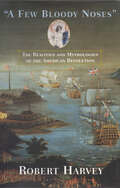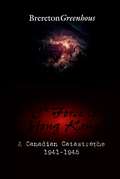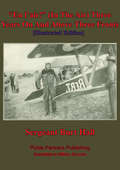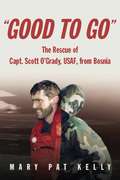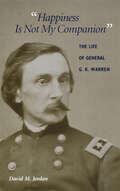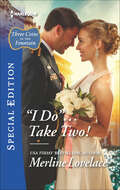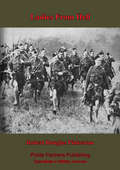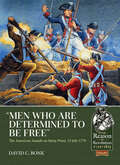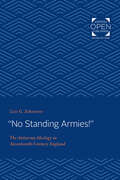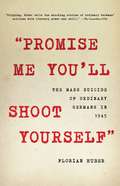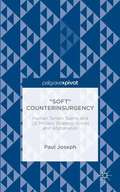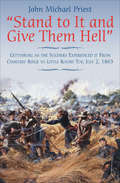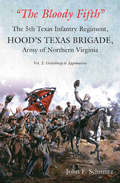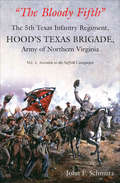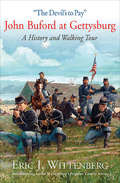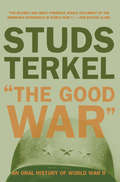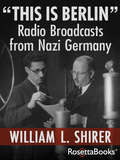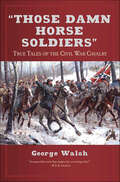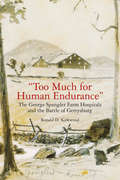- Table View
- List View
"A Few Bloody Noses": The Realities and Mythologies of the American Revolution
by Robert HarveyThe noted British historian and author of Liberators offers a colorful, enlightening and myth-busting history of the American Revolution.According to King George III, Britain merely wanted to give America “a few bloody noses” and return to mutual cooperation. Yet the ensuing uprising led to the creation of the United States, the most powerful country in the modern world. In “A Few Bloody Noses”, Robert Harvey challenges conventional views of the American Revolution in almost every aspect—why it happened; who was winning and when; the characters of the principal protagonists; and the role of Native Americans and enslaved people. Harvey takes a penetrating look at a war that was both vicious and confused, bloody and protracted, and marred on both sides by incompetence and bad faith. He underscores the effect of the Revolution on the settlers in America, and those at home in Britain—the country that the settlers had left behind, and to which many returned. The result is an extraordinarily fascinating and thoroughly readable account.
"A Magnificent Fight"
by Robert J. CressmanThis book recounts how the Wake Island garrison survived nearly daily bombings and repulsed the first Japanese attempt to take the atoll. The author uses extensive Japanese materials--many never before used or available-- to identify the enemy order of battle and the roles each unit played in the drama.
"A" Force
by Whitney BendeckJune 1940. The Italians declared war on the British. Completely unprepared for war, the British had only 35,000 troops to defend Egypt. Opposing them, the Italian army in Libya numbered at least 215,000; in East Africa, the Italians could muster another 200,000 men against a meager 19,000 British and commonwealth troops positioned in the Sudan and East Africa. Out-numbered and unlikely to receive sizable reinforcements of men or desperately needed supplies, it is surprising that the British survived. But they did. How? They got creative. Under the leadership of General Archibald P. Wavell, the commander-in-chief of the Middle East, the British set out to greatly exaggerate the size of their forces, supply levels, and state of battle readiness. When their deceitful charades proved successful, Wavell turned trickery into a profession and created an entirely new agency dedicated to carrying out deception. "A" Force: The Origins of British Military Deception during the Second World War looks at how and why the British first employed deception in WWII. More specifically, it traces the development of the "A" Force organization - the first British organization to practice both tactical and strategic deception in the field. Formed in Cairo in 1941, "A" Force was headed by an unconventional colonel named Dudley Wrangel Clarke. Because there was no precedent for Clarke's "A" Force, it truly functioned on a trial-and-error basis. The learning curve was steep, but Clarke was up for the challenge. By the Battle of El Alamein, British deception had reach maturity. Moreover, it was there that the deceptionists established the deception blueprint later used by the London planners used to plan and execute Operation Bodyguard, the campaign to conceal Allied intentions regarding the well-known D-day landing at Normandy. In contrast to earlier deception histories that have tended to focus on Britain's later deception coups (Bodyguard), thus giving the impression that London masterminded Britain's deception efforts, this work clearly shows that British deception was forged much earlier in the deserts of Africa under the leadership of Dudley Clarke, not London. Moreover, it was born not out of opportunity, but out of sheer desperation. A" Force explores an area of deception history that has often been neglected. While older studies and documentaries focused on the D-day deception campaign and Britain's infamous double-agents, this work explores the origins of Britain's deception activities to reveal how the British became such masterful deceivers.
"C" Force to Hong Kong: A Canadian Catastrophe
by Brereton GreenhousThis is the story of a “no military risk” campaign that slowly turned into a nightmare. The book provides new answers to a number of difficult questions beginning with a discussion of why Canadian troops were sent to Hong Kong at the request of the British War Office. Were the British duplicitous in making this request? Was Canadian Chief of the General Staff, Lieutenant-General Harry Crerar, guilty of putting his own interests above those of his men in telling the minister of National Defence that there was “no military risk” in sending the “C” Force? The book recounts the formation of the “C” Force and its departure to Hong Kong where it arrived just three weeks before the Japanese attack. It outlines the course of the battle from December 8, 1941, until the inevitable surrender of the garrison on Christmas Day. It places appropriate emphasis on the Canadian contribution, refuting 1947 allegations by the British General-Officer-Commanding — allegations which were only made public in 1993 — that the Canadians did not fight well. Greenhous attacks these charges with solid evidence from participants and eye-witnesses. Finally, the book tells the story of life and death in the prison camps of Hong Kong and Japan.
"Dual Containment" Policy in the Persian Gulf
by Alex EdwardsThis book offers a concise account of US "dual containment" policy towards Iran and Iraq during the 1990s, an overlooked era between the tumult of the liberation of Kuwait and the terrorist attacks of September 11, 2001. In particular, it uses a theoretical framework derived from neoclassical realism to examine the impact of domestic US politics and interest groups on policymaking, as well as perceptions of threat derived from two decades of mutual hostility between the US and Iran.
"En L'air!" (In The Air) Three Years On And Above Three Fronts [Illustrated Edition]
by Segeant Bert HallSergeant Bert Hall belonged to an elite brotherhood; he was a founded member of the Lafayette Escadrille which fought in the colours of France during the First World War. Highly decorated individually and as a unit; Hall flew alongside the first American aviators such as Kiffin Rockwell, John Thaw, Victor Chapman and Raoul Lufbery.His first autobiography is gritty and adventure filled; recording his time spent in the French Foreign Legion and in the Trenches before his transfer to flying duties with the Lafayette squadron.Author -- Sergeant Hall, Bert, 1886-1948.Text taken, whole and complete, from the edition published in New York, N.Y., The new library, inc. 1918Original Page Count - 153 pages.Illustrations -- 10 Illustrations.
"Good to Go"
by Mary Pat KellySo perfectly executed was the mission to rescue Capt. Scott O'Grady that it amazed even the men responsible. Just five hours after radio contact was first made with Basher 52 - O'Grady's call sign the Air Force captain was safely on board the USS Kearsarge. The downed F-16 fighter pilot's rescue from a Bosnian mountainside by Col. Martin Berndt's 24th Marine Expeditionary Unit electrified the nation in June 1995 and renewed many Americans' faith in the military. This book tells the story of the mission in the words of the men who commanded, planned, and carried it out. To get the inside account, Mary Pat Kelly traveled throughout Europe to conduct more than one hundred interviews, visiting U. S. ships and bases and UN posts in Croatia and Bosnia where participants were stationed. Admiral Leighton W. Smith Jr. , commander in chief of U. S. naval forces in Europe and head of NATO forces in the Southern European theater, provides the framework with his day-to-day commentary on the efforts to find Captain O'Grady and a nearly minute-by-minute record of the rescue itself. In concert with Lt. Gen. Michael E. Ryan, commander of U. S. and NATO air forces, the admiral reveals the decision-making process that led to the "Good to Go" order. Readers then hear from the Tactical Recovery of Aircraft and Personnel (TRAP) team-the Navy and Marine Corps commanders, pilots, crew chiefs, and grunts who made it happen. Speaking for the Navy are Capt. Christopher Cole, skipper of the Kearsarge, Commo. Jerome Schill, and their staffs, from the intelligence officers to the grapes who fueled the aircraft. Captain O'Grady puts his own experiences in the context of overall events.
"Happiness Is Not My Companion": The Life of General G. K. Warren
by David M. JordanThe valorous but troubled career of the Civil War general best known for defending Little Round Top and averting a Union defeat at Gettysburg.The lieutenant colonel of a New York regiment and rising star in the Army of the Potomac, Gouverneur K. Warren performed heroically at Gettysburg. For his service at Bristoe Station and Mine Run, he was awarded command of the Fifth Corps for the 1864 Virginia campaign.But Warren’s peculiarities of temperament and personality put a cloud over his service at the Wilderness and Spotsylvania and cost him the confidence of his superiors, Grant and Meade. He was summarily relieved of his command by Philip Sheridan after winning the Battle of Five Forks, just eight days before Appomattox. Warren continued as an engineer of distinction in the Army after the war, but he was determined to clear his name before a board of inquiry, which conducted an exhaustive investigation into the battle, Warren’s conduct, and Sheridan’s arbitrary action. However, the findings of the court vindicating Warren were not made public until shortly after his death.For this major biography of Gouverneur Warren, David M. Jordan utilizes Warren’s own voluminous collection of letters, papers, orders, and other items saved by his family, as well as the letters and writings of such contemporaries as his aide and brother-in-law Washington Roebling, Andrew Humphreys, Winfield Hancock, George Gordon Meade, and Ulysses S. Grant. Jordan presents a vivid account of the life and times of a complex military figure.
"I Do" . . . Take Two!: Take Two! (Three Coins in the Fountain #1)
by Merline LovelaceHER PERFECT ROMAN HOLIDAY A Roman reunion isn't on Kate Westbrook's itinerary when she arrives in Italy. After all, she's flying solo on the vacation she'd hoped to share with her soon-to-be-ex. But when Kate tosses a coin into the Trevi Fountain, her deepest wish-a second chance with her gorgeous pilot husband-might come true... Travis knows his dangerous missions broke up his marriage, but he's determined to win back his wife. How can Kate resist the magic and moonlight of Venice, followed by a passionate interlude in a sun-drenched Tuscan villa? Now, instead of dodging missiles, Travis faces a far more daunting challenge: proving to the woman he adores that their love is as enduring as the Eternal City itself.
"Ladies From Hell,"
by Robert Douglas Pinkerton"With the London-Scottish Regiment During the First World WarThe 'Cockney Jocks' at war in Flanders and FranceThe wide distribution of Scots throughout Britain and the Empire led to the formation new 'Scottish' regiments and the London Scottish, formed in 1859 as a volunteer rifle corps and originally commanded by Lord Elcho, was a primary example. Elcho, anxious to embrace all the fighting men of Scotland into one brotherhood irrespective of their clan origins, uniquely clad the regiment in kilts of 'Hodden Grey,' a traditional hard wearing Scottish homespun cloth devoid of the tartan check and, as he perceived, being a drab colour suited for life on military campaign in the most practical way. Pinkerton, the author of this book was a soldier among the ranks of the regiment who answered the nation's call to arms during the First World War. The regiment was mobilised at the outbreak of hostilities and the 1st battalion had the distinction of being the first Territorials to go into action during operations at Messines in October 1914. Pinkerton takes his readers to war with the London Scottish on the western front where it took part in all the major offensives of the conflict. Predictably this vital account is filled with immediate first hand account action and anecdotes and is essential reading for anyone interested in the war in the trenches the kilted infantry knew."-Leonaur Print VersionAuthor -- Pinkerton, Robert Douglas.Text taken, whole and complete, from the edition published in New York, The Century co., 1918.Original Page Count - 254 pages.
"Men who are Determined to be Free": The American Assault on Stony Point, 15 July 1779 (From Reason to Revolution)
by David C. BonkDuring 1779, armies under the command of American General George Washington and British General Sir William Clinton were locked in a strategic stalemate. The entry of the French into the war as American allies had shifted the strategic initiative and caused the British government to order Clinton to dispatch significant forces to the West Indies and southern colonies. The reduction in his available forces hampered Clinton’s efforts to bring Washington to a decisive engagement. Clinton decided to launch an attack north from New York to establish a base of operations that would allow an attack on the American fortress at West Point. In late June 1779 Clinton moved men and materiel into position for his thrust up the Hudson while Washington cautiously responded by moving his army north. Clinton struck on 3 July 1779, capturing the strategic Kings Ferry crossing of the Hudson River along with American forts at Stony Point and Verplank’s Point. Soon after Washington began to develop an audacious plan to recapture the strongpoint and restore American fortunes. After organizing an elite force of light infantry, Washington spent several days observing the British position at Stony Point and collecting intelligence on British defenses. He proposed a nighttime assault. At midnight on 15 July, 1779 Washington directed Brigadier General Anthony Wayne to lead 1,300 men against the British defenders of Stony Point. In little over one hour the American light infantry captured Stony Point With news of the American victory Washington quickly rode to the fort to congratulate Wayne and his men. Recognizing that he had neither the troops nor the resources needed to defend Stony Point against an expected British counterattack Washington ordered all supplies and arms to be removed, prisoners marched into captivity and the fortifications destroyed. Although the British did successfully reoccupy Stony Point several days later, the Americans trumpeted their unexpected victory and a chagrined General Clinton concluded a further offensive up the Hudson River towards West Point would be pointless.
"No Standing Armies!": The Antiarmy Ideology in Seventeenth-Century England
by Lois G. SchwoererOriginally published in 1974. In her study of primary materials in England and the United States, Schwoerer traces the origin, development, and articulation in both Parliament and in the popular press of the attitude opposing standing armies in seventeenth-century England and the American colonies. Central to the criticism of armies at that time was the conviction that ultimate military power should be vested in Parliament, not the Crown. Schwoerer shows how the many diverse elements of England's antimilitarism, including political principle, propaganda, parliamentary tactics, parochialism, and partisanship, hardened with every confrontation between the Crown or Protector and Parliament. The author finds a general predisposition to distrust professional soldiers early in the century, and from the 1620s onward she notes opposition to a standing army in times of peace. Highlighting the growth of the antimilitary tradition, Schwoerer traces the development of this attitude from the Petition of Right in 1628 to the 1641–1642 crisis over the Militia Bill/Ordinance, the military settlements of 1660 and 1689, and the climactic events of 1667–1699. Schwoerer shows how the anti-standing-army ideology affected the constitutional thinking of the American colonists and manifested itself in the Constitution and the Bill of Rights. She addresses timeless questions of how to provide for a nation's defense while preserving individual liberty, citizen responsibility for military service, and the relationship of executive and legislative authority over the army.
"Old Slow Town": Detroit During the Civil War
by Paul TaylorThough it was located far away from Southern battlefields, Detroit churned with unrest during the American Civil War. The city's population, including a large German and Irish immigrant community, mostly aligned with anti-war Democrats while the rest of the state stood with the pro-Lincoln Republicans. The virulently anti-Lincoln and anti-Black Detroit Free Press fanned the city's flames with provocative coverage of events. In "Old Slow Town": Detroit during the Civil War, award-winning author Paul Taylor contends that the anger within Detroit's diverse political and ethnic communities over questions about the war's purpose and its conduct nearly tore the city in two. Taylor charts Civil War-era Detroit's evolution from a quiet but growing industrial city (derisively called "old slow town" by some visitors) to a center of political contention and controversy. In eight chapters, Taylor details topics including the pre-war ethnic and commercial development of the city; fear and suspicion of "secret societies"; issues of race, gender, and economic strife during the war; Detroit's response to its soldiers' needs; and celebration and remembrance at the conclusion of the conflict. Taylor's use of rarely seen military correspondence from the National Archives, soldier and civilian diaries and letters, period articles and editorials from Detroit's Civil War-era newspapers, and his fresh, judicious synthesis of secondary sources results in a captivating depiction of Detroit's Civil War history. Until now, why events occurred as they did in Detroit during the Civil War and what life was like for its residents has only been touched upon in any number of general histories. Readers interested in American history, Civil War history, or the ethnic history of Detroit will appreciate the full picture of the time period Taylor presents in "Old Slow Town."
"Our Gallant Doctor": Surgeon-Lieutenant George Hendry and HMCS Ottawa, 1942
by James GoodwinDuring the Battle of the Atlantic, Dr. George Hendry had just finished performing two major surgical operations on board the destroyer HMCS Ottawa when his ship was ambushed by 13 German U-boats. Canadian warships like Ottawa had inadequate radar sets that were incapable of detecting submarines approaching in the dark. On September 13, 1942, U-91 stole in and torpedoed Ottawa, sinking her in 20 minutes. utterly exhausted, Dr. Hendry was lost along with 113 of his shipmates. George Hendry was a much-loved man, a great university athlete, and a very good doctor. Unfortunately, he was also naive and too trusting. One night in January 1941, he committed a very foolish indiscretion. He would spend the rest of his tragically short life making amends for this mistake.
"Promise Me You'll Shoot Yourself": The Mass Suicide of Ordinary Germans in 1945
by Florian HuberNamed a Best History Book of 2019 by The Times (UK)The astounding true story of how thousands of ordinary Germans, overcome by shame, guilt, and fear, killed themselves after the fall of the Third Reich and the end of World War II.By the end of April 1945 in Germany, the Third Reich had fallen and invasion was underway. As the Red Army advanced, horrifying stories spread about the depravity of its soldiers. For many German people, there seemed to be nothing left but disgrace and despair. For tens of thousands of them, the only option was to choose death -- for themselves and for their children. "Promise Me You'll Shoot Yourself" recounts this little-known mass event. Using diaries, letters, and memoirs, historian Florian Huber traces the euphoria of many ordinary Germans as Hitler restored national pride; their indifference as the Führer's political enemies, Jews, and other minorities began to suffer; and the descent into despair as the war took its terrible toll, especially after the invasion of the Soviet Union. Above all, he investigates how suicide became a contagious epidemic as the country collapsed.Drawing on eyewitness accounts and other primary sources, "Promise Me You'll Shoot Yourself" presents a riveting portrait of a nation in crisis, and sheds light on a dramatic yet largely unknown episode of postwar Germany.
"Soft" Counterinsurgency: Human Terrain Teams and US Military Strategy in Iraq and Afghanistan
by Paul JosephSoft Counterinsurgency reviews the promises and achievements of Human Terrain Teams, the small groups of social scientists that were eventually embedded in every combat brigade in Iraq and Afghanistan.
"Stand to It and Give Them Hell": Gettysburg as the Soldiers Experienced it From Cemetery Ridge to Little Round Top, July 2, 1863
by John Michael PriestStand to It and Give Them Hell chronicles the Gettysburg fighting from Cemetery Ridge to Little Round Top on July 2, 1863, through the letters, memoirs, diaries, and postwar recollections of the men from both armies who struggled to control that hallowed ground.John Michael Priest, dubbed the Ernie Pyle of the Civil War soldier, wrote this book to help readers understand and experience, as closely as possible through the written word, the stress and terror of that fateful day in Pennsylvania. Readers will gain a deeper appreciation of the personal sacrifice made that awful day by privates and generals alike. This invaluable method uses their own words to paint a rich tapestry of their personal courage and cowardice, and their failures and triumphs.Nearly 60 detailed maps, mostly on the regimental level, illustrate the tremendous troop congestion in the Wheatfield, the Peach Orchard, and Devils Den. They accurately establish, by regiment or by company, the extent of the Federal skirmish line from Zieglers Grove to the Slyder farm and portray the final Confederate push against the Codori farm and the center of Cemetery Ridge, which three Confederate divisions in what is popularly known as Picketts Charge would unsuccessfully attack on the final day of fighting.This is a book about combat as seen through the eyes of those who waged it. There is no glamour here, and no adventure. Nor are there accusations, confessions, or second-guessing from the comfort of an easy chair. Instead, Stand to It and Give Them Hell offers the brutal, heart-wrenching story of a slice of Americas greatest battle as described by those who marched, fought, bled, and died there. This is their story, and it is one you will long remember.
"The Bloody Fifth": Gettysburg to Appomattox (The 5th Texas Infantry Regiment, Hood's Texas Brigade, Army of Northern Virginia #2)
by John SchmutzThe second installment in a sweeping history of the 5th Texas InfantryThe Bloody Fifthone of only three Texas regiments to fight with Robert E. Lees Army of Northern Virginia. The 5th Texas established an exceptional combat record in an army known for its fighting capabilities. The regiment took part in 38 engagements, including nearly every significant battle in the Eastern Theater, as well as the Chickamauga, Chattanooga, and Knoxville campaigns in the Western Theater. The Bloody Fifth offers the first full-length study documenting this fabled regimental command.The first volume, Secession through the Suffolk Campaign, followed the regiment from its inception through the successful foraging campaign in southeastern Virginia in April 1863. Gettysburg to Appomattox continues the regiments rich history from its march north into Pennsylvania and the battle of Gettysburg, its transfer west to Georgia and participation in the bloody battle of Chickamauga, operations in East Tennessee, and the regiments return to Virginia for the overland battles (Wilderness to Cold Harbor), Petersburg campaign, and the march to Appomattox Court House. The narrative ends by following many of the regiments soldiers on their long journey home.Schmutzs definitive study is based upon years of archival and battlefield research that uncovered hundreds of primary sources, many never before used. The result is a lively account of not only the regiments marches and battles but a personal look into the lives of these Texans as they struggled to survive a vicious war more than 1,000 miles from home.The Bloody FifthThe 5th Texas Infantry Regiment, Hoods Texas Brigade, Army of Northern Virginia, with photos, original maps, explanatory footnotes, and important and useful appendices, is a significant contribution to the history of Texas and the American Civil War.
"The Bloody Fifth": The 5th Texas Infantry, Hood's Texas Brigade, Army Of Northern Virginia (The 5th Texas Infantry Regiment, Hood's Texas Brigade, Army of Northern Virginia #1)
by John F. SchmutzThe 5th Texas InfantryThe Bloody Fifthwas one of only three Texas regiments to fight with Robert E. Lees Army of Northern Virginia. Much like the army in which it served, the 5th Texas established a stellar combat record. The regiment took part in 38 engagements, including nearly every significant battle in the Eastern Theater, as well as the Chickamauga, Chattanooga, and Knoxville campaigns in the Western Theater. John F. Schmutzs The Bloody Fifth: The 5th Texas Infantry, Hoods Texas Brigade, Army of Northern Virginia is the first full-length study to document this fabled regimental command.The Bloody Fifth presents the regiments rich history from the secession of the Lone Star State and the organization of ten independent east and central Texas companies, through four years of arduous marching and fighting. The 5th Texass battlefield exploits are legendary, from its inaugural fighting on the Virginia peninsula in early 1862 through Appomattox. At Gettysburg, the Texans suffered horrendous losses repeatedly assaulting Little Round Tops rocky slopes, and in the Wilderness on May 6, 1864, helped save the collapsing Confederate line while the eyes of General Lee were upon them. But it was at Second Manassas where the regiment earned its enduring nickname by attacking and crushing the 5th New York Zouaves. Flushed with victory, the Texans pushed through the disintegrating Federal lines and outdistanced the remainder of the Brigadeas well as the rest of the Confederate army. In his official report on the battle, Gen. John Bell Hood, boasted that the 5th Texas had slipped the bridle. Its exploits that day earned the regiment its undying sobriquet The Bloody Fifth.Schmutzs monumental regimental history, which also details the personal lives of these Texas soldiers as they struggled to survive the war some 2,000 miles from home, is based upon years of archival research that has uncovered hundreds of primary sources. Complete with photos and original maps, The Bloody Fifth: The 5th Texas Infantry, Hoods Texas Brigade, Army of Northern Virginia is a significant contribution to the growing literature of the Civil War.
"The Devil's to Pay": John Buford at Gettysburg: A History and Walking Tour
by Eric J. WittenbergAn award-winning Civil War historian’s profile of the brilliant Union cavalry officer and the strategies he employed to prevent catastrophe at Gettysburg. The Battle of Gettysburg turned the tide of the Civil War. But the outcome of the decisive confrontation between North and South might have been dramatically different if not for the actions of Brig. Gen. John Buford, commander of the Union army’s First Cavalry Division. An award-winning chronicler of America’s War between the States and author of more than a dozen acclaimed works of historical scholarship, Eric J. Wittenberg now focuses on the iconic commanding officer known to his troops as “Honest John” and “Old Steadfast.” Wittenberg describes in fascinating detail the brilliant maneuvers Buford undertook to keep Gen. Robert E. Lee’s Confederate army at bay and later rescue what remained of the devastated First and Eleventh Corps.”The Devil’s to Pay” celebrates the stunning military achievements of an unparalleled tactical genius at the onset of the Gettysburg Campaign and paints an unforgettable portrait of a quiet, unassuming cavalryman who recognized a possible disaster in the making and took bold action to avert it. Based on a wealth of information from primary sources, “The Devil’s to Pay” includes pages of illustrations, maps, and photographs, as well as a walking and driving tour of the battlefield sites where America’s history was made at a staggeringly high cost in blood. A comprehensive tactical study that is both scholarly and eminently accessible, it is an essential addition to the library of any Civil War enthusiast.
"The Good War": An Oral History of World War II
by Studs TerkelWinner of the Pulitzer Prize: &“The richest and most powerful single document of the American experience in World War II&” (The Boston Globe). &“The Good War&” is a testament not only to the experience of war but to the extraordinary skill of Studs Terkel as an interviewer and oral historian. From a pipe fitter&’s apprentice at Pearl Harbor to a crew member of the flight that dropped the atomic bomb on Nagasaki, his subjects are open and unrelenting in their analyses of themselves and their experiences, producing what People magazine has called &“a splendid epic history&” of WWII. With this volume Terkel expanded his scope to the global and the historical, and the result is a masterpiece of oral history. &“Tremendously compelling, somehow dramatic and intimate at the same time, as if one has stumbled on private accounts in letters locked in attic trunks . . . In terms of plain human interest, Mr. Terkel may well have put together the most vivid collection of World War II sketches ever gathered between covers.&” —The New York Times Book Review &“I promise you will remember your war years, if you were alive then, with extraordinary vividness as you go through Studs Terkel&’s book. Or, if you are too young to remember, this is the best place to get a sense of what people were feeling.&” —Chicago Tribune &“A powerful book, repeatedly moving and profoundly disturbing.&” —People
"This Is Berlin": Radio Broadcasts from Nazi Germany
by William L. ShirerThe legendary CBS news journalist&’s selection of iconic World War II radio broadcasts from countries throughout Europe. William L. Shirer was the first journalist hired by CBS to cover World War II in Europe, where he continued to work for over a decade as a news broadcaster. This book compiles two and a half years&’ worth of wartime broadcasts from Shirer&’s time on the ground during WWII. He was with Nazi forces when Hitler invaded Austria and made it a part of Germany under the Anschluss; he was also the first to report back to the United States on the armistice between France and Nazi forces in June of 1940. His daily roundup of news from Paris, Vienna, Berlin, Rome, and London, which documented Nazi Germany and the conditions of countries under invasion and at war, became famous for its gripping urgency. Shirer brought a sense of immediacy to the war for listeners in the United States and worldwide, and his later books, including the seminal Rise and Fall of the Third Reich, became definitive works on World War II history. This collection of Shirer&’s radio broadcasts offers all the original suspense and vivid storytelling of the time, bringing World War II to life for a modern audience.
"Those Damn Horse Soldiers": True Tales of the Civil War Cavalry
by George WalshThe historian and author of Whip the Rebellion shares “an excellent popular history of Civil War cavalry” from the outbreak of war to its bitter end (Booklist).Many accounts of the Civil War battles, armies, and key figures have been written over the years, but none have looked at the bloodiest war in our nation’s history through the eyes of the cavalry. The horse soldiers in the Civil War are often referred to as the last of the cavaliers, men who valued their honor as much as their cause.In this sweeping history, George Walsh brings to life anew the gallant horse soldiers of the North and South, showing in dramatic detail how their raids and expeditions affected the outcome of the war and how their fortunes waxed and waned. Walsh offers vivid portraits of cavalrymen such as Fitzhugh Lee, son of Confederate commanding general Robert E. Lee; the “Gray Ghost” John Singleton Mosby; the young and fiery George Armstrong Custer; and many others.
"Too Much for Human Endurance": The George Spangler Farm Hospitals and the Battle of Gettysburg
by Ronald D. KirkwoodThe bloodstains are gone, but the worn floorboards remain. The doctors, nurses, and patients who toiled and suffered and ached for home at the Army of the Potomac’s XI Corps hospital at the George Spangler Farm in Gettysburg have long since departed. Happily, though, their stories remain, and noted journalist and George Spangler Farm expert Ronald D. Kirkwood brings these people and their experiences to life in “Too Much for Human Endurance”: The George Spangler Farm Hospitals and the Battle of Gettysburg. Using a massive array of firsthand accounts, Kirkwood re-creates the sprawling XI Corps hospital complex and the people who labored and suffered there—especially George and Elizabeth Spangler and their four children, who built a thriving 166-acre farm only to witness it nearly destroyed when war paid them a bloody visit that summer of 1863. Stories rarely if ever told of nurses, surgeons, ambulance workers, musicians, teenage fighters, and others are weaved seamlessly through gripping, smooth-flowing prose. A host of notables spent time at the Spangler farm, including Union officers George G. Meade, Henry J. Hunt, Edward E. Cross, Francis Barlow, Francis Mahler, Freeman McGilvery, and Samuel K. Zook. Pvt. George Nixon III, great-grandfather of President Richard M. Nixon, would die there, as would Confederate Gen. Lewis A. Armistead, who fell mortally wounded at the height of Pickett’s Charge. In addition to including the most complete lists ever published of the dead, wounded, and surgeons at the Spanglers’ XI Corps hospital, this study breaks new ground with stories of the First Division, II Corps hospital at the Spanglers’ Granite Schoolhouse. Kirkwood also establishes the often-overlooked strategic importance of the property and its key role in the Union victory. Army of the Potomac generals took advantage of the farm’s size, access to roads, and central location to use it as a staging area to get artillery and infantry to the embattled front line from Little Round Top north to Cemetery Hill just in time to prevent its collapse and a Confederate breakthrough. “Too Much for Human Endurance”: The George Spangler Farm Hospitals and the Battle of Gettysburg introduces readers to heretofore untold stories of the Spanglers, their farm, those who labored to save lives and those who suffered and died there. They have finally received the recognition their place in history deserves.
"Unsinkable": The Full Story of RMS Titanic
by Daniel Allen ButlerThis passionate yet balanced narrative explores every facet of the Titanic's history, including her spectacular conception in an Irish shipyard and the ambitious modern-day attempts to salvage her. The familiar story of the RMS Titanic-from her encounter with an iceberg to her demise some three hours later, taking with her more than fifteen hundred people-still looms large in the popular imagination, and in Daniel Butler's as well. He studied the Titanic's history for thirty years, intensively compiling facts about the disaster and the players involved (from Captain Smith and his crew to the ill-fated third-class passengers). He even made the startling discovery of a nearby ship that ignored the Titanic's distress call because the shipmates were afraid to awaken their captain. Drawn from primary sources and period accounts, this new narrative puts the disaster into historical context and serves as an essential resource for scholars of Titanic lore.
